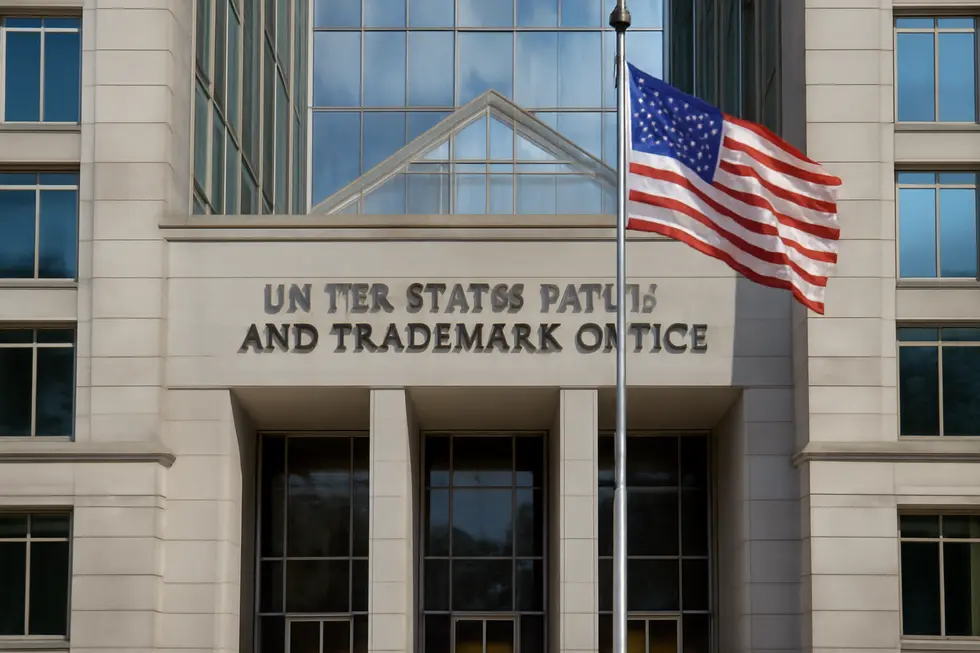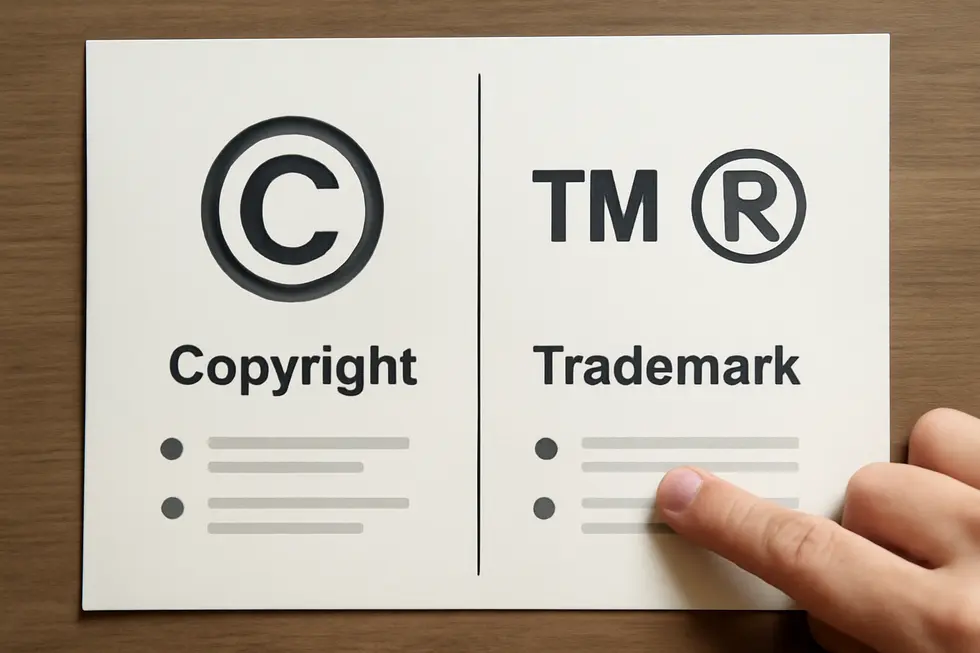Introduction
Choosing a company name is one of the most important early steps in establishing your business, but protecting that name requires a clear understanding of intellectual property law. While many business owners may assume copyright safeguards their company name, the reality is different: company names fall under trademark protection, not copyright. Grasping this difference is essential to securing your brand’s identity and avoiding costly infringements. This article guides you through the critical aspects of protecting your company name, starting with how trademark protection differs from copyright. It then walks you through the legal registration process, advises on conducting thorough trademark searches, and highlights the pivotal role of the U.S. Patent and Trademark Office (USPTO). Finally, you’ll gain a comprehensive understanding of intellectual property rights, enabling you to safeguard your business name confidently and effectively.
Tables of Contents
Chapter 1: Trademark Protection vs. Copyright for a Copyright Company Name
- Understanding the Legal Framework: Why Trademarks, Not Copyrights, Protect Your Company Name
- Why Distinctiveness and Commercial Use Define Trademark Rights Over Copyright for Company Names
- Navigating Federal and State Trademark Protections for a Copyright Company Name
- Effective Strategies for Securing Your Company Name Through Trademark, Not Copyright
Chapter 2: Legal Registration Process for a Copyright Company Name
- Essential Name Availability Checks and Registration Steps for Trademark Protection
- Navigating Application Preparation and Filing Requirements to Safeguard Your Company Name
- Navigating the Examination, Opposition, and Approval Stages of Company Name Registration
- Understanding the Essential Differences in Registering Business Names, Trademarks, and Copyrights
Chapter 3: Searching Trademark Availability for a Copyright Company Name
- Harnessing Advanced Technologies to Secure Trademark Availability for Your Company Name
- Balancing Economic Investment and Legal Strategy in Trademark Searches for Company Names
- Navigating Geopolitical and Regulatory Complexities When Searching Trademarks for Your Company Name
- How Trademark Searches Safeguard Your Brand and Society in Company Naming
Chapter 4: Role of USPTO in Protecting a Copyright Company Name
- USPTO’s Crucial Role in Safeguarding Company Names Through Federal Trademark Registration
- Distinctiveness at the Core: Navigating the USPTO Examination for Trademark Protection
- Navigating Enforcement and Legal Remedies for Company Name Protection Through the USPTO
- Navigating the Strengths and Limits of USPTO Federal Registration Versus Common Law for Company Name Protection
Chapter 5: Understanding Intellectual Property: Copyright vs. Trademark for a Copyright Company Name
- Legal Protections and Key Differences Between Copyright and Trademark for Company Names
- Securing Your Company’s Identity: Why Trademark Registration, Not Copyright, Shields Your Business Name
- Essential Steps to Trademark Your Copyright Company Name for Legal Exclusivity
- Harnessing Trademark Exclusivity: Economic Power and Market Control for Your Company Name
Chapter 1: Trademark Protection vs. Copyright for a Copyright Company Name

1. Understanding the Legal Framework: Why Trademarks, Not Copyrights, Protect Your Company Name
The legal foundation differentiating trademark protection from copyright in relation to a company name is clear and essential. Company names serve as brand identifiers in commerce and are protected under trademark law, not copyright. Trademarks safeguard business names, logos, and slogans that distinguish goods or services from others. Protection arises through actual use in commerce, but registration with the U.S. Patent and Trademark Office (USPTO) enhances these rights nationwide and grants stronger legal presumption of ownership. Unlike trademarks, copyright protects original creative works fixed in tangible form, such as literature, music, and artwork. Importantly, copyright does not extend to names, titles, or short phrases, meaning a company name—even one including “copyright”—cannot be protected by copyright. Trademark protection is indefinite, maintained through continued use and renewal, and it prevents others from using confusingly similar names in commerce, securing the company’s brand identity. In contrast, copyright protects creative content from unauthorized copying, with duration tied to the creator’s life plus 70 years, but offers no protection against the use of a company name. For a business operating in copyright-related fields, registering the company name as a trademark is the legally appropriate step to secure exclusive rights and remedies against infringement. For further insight on trademark necessity, see do I need a trademark for my business.
2. Why Distinctiveness and Commercial Use Define Trademark Rights Over Copyright for Company Names
Company names for copyright businesses are not covered by copyright law, as copyright excludes names, titles, and short phrases due to their lack of originality. Instead, such names gain legal protection under trademark law, which safeguards distinctive identifiers used in commerce to specify the origin of goods or services. The cornerstone of trademark protection lies in the company’s name being distinctive enough to stand out and actively used in commercial settings. Generic or purely descriptive names usually fail to qualify unless they develop a “secondary meaning,” where consumers directly associate the name with a specific business rather than a general category.
Trademark rights stem from the name’s actual use in the marketplace to uniquely identify products or services. Merely owning or privately using a name does not establish these rights. Federal trademark registration with the USPTO amplifies this protection by granting exclusive nationwide rights and legal tools to prevent infringement. Meanwhile, copyright protects original creative works fixed in tangible forms, such as texts or music, explicitly excluding business names from coverage. Thus, for a copyright company name, trademark protection hinges on two critical requirements: distinctiveness and commercial use—a foundation integral to maintaining a secure and exclusive brand identity.
To explore the essential steps to protect your company name through trademark registration, see when to register a trademark for your business.
Wolters Kluwer expert insight offers further detail on differentiating trademarks from copyrights and securing brand protection.
3. Navigating Federal and State Trademark Protections for a Copyright Company Name
Understanding the federal and state distinctions in protecting a copyright company name is key to securing your brand’s identity. Trademark protection, which covers company names, logos, and branding elements, gains its fullest strength through federal registration with the United States Patent and Trademark Office (USPTO). A federal trademark provides exclusive, nationwide rights to use the name in connection with specified goods or services, preventing others from using confusingly similar marks across all states.
In contrast, state-level business name registration only prevents identical names within that state’s jurisdiction. This registration primarily manages business filings and does not confer intellectual property rights or national exclusivity. Consequently, competitors can use the same or similar names outside that state without infringement.
Copyright law differs fundamentally, shielding original creative works rather than company names. Since a company name is typically a short phrase, it falls outside copyright’s protection scope. Instead, copyright protects the creative expressions produced by the company but not the name itself.
In practical terms, relying solely on state registration leaves your copyright company name vulnerable to duplication beyond that region. Federal trademark registration, however, offers robust, enforceable rights nationwide. For deeper insights on when and how to secure trademark rights for your business name, exploring expert guidance on trademark registration can be invaluable.
4. Effective Strategies for Securing Your Company Name Through Trademark, Not Copyright
Protecting a company name effectively requires understanding that trademark law—not copyright—offers meaningful safeguards. Company names are usually too brief and lack the originality to qualify for copyright protection. Instead, trademarks identify your business’s goods or services in commerce, helping consumers distinguish your brand in the marketplace. To maximize protection, registering your trademark federally with the USPTO is essential. Federal registration grants exclusive rights nationwide and legal advantages when enforcing against infringers. While state-level business name registration safeguards against local duplicates, it does not stop others from using identical or confusingly similar names in commerce or across different states. A valid trademark must be distinctive and used commercially; generic or merely descriptive names without a recognized secondary meaning generally do not qualify. Beyond protecting just names, trademarks cover logos, slogans, and product names, all critical for preserving brand identity. Since copyright protects creative content like writing or artwork, many companies benefit from combining copyright for their original works with trademark registration for their name. This dual approach ensures your brand is protected comprehensively, securing your business reputation and presence. For more detailed guidance on registering trademarks, businesses can refer to expert insights such as those found at Trademark2Go.
Chapter 2: Legal Registration Process for a Copyright Company Name

1. Essential Name Availability Checks and Registration Steps for Trademark Protection
The initial phase in registering a company name with trademark considerations involves thorough availability checks to avoid legal conflicts and ensure exclusive rights. Start by searching your state’s business registry, often accessible online through the Secretary of State’s office, to confirm the name isn’t already in use locally. Many states offer the option to reserve a name temporarily during the formation process, preventing others from registering it concurrently.
Simultaneously, a federal search within the USPTO’s Trademark Electronic Search System (TESS) is critical to detect any existing trademarks that might clash with your proposed name nationwide. This step safeguards against infringement and lays the groundwork for broader trademark protection if your business operates beyond state lines.
Alongside government databases, verifying domain name availability is equally important for maintaining brand consistency online. Once these checks confirm your name’s uniqueness, you can proceed with filing formation documents at the state level to officially register your company.
For stronger protection, submitting a trademark application to the USPTO establishes federally recognized rights, including a review and opposition period before registration is granted. Though copyright protection doesn’t extend to company names, original creative works produced by the company—like logos or written content—can be registered separately with the U.S. Copyright Office to bolster intellectual property defenses.
These steps ensure your company name is legally available and protected at multiple levels, helping avoid costly disputes and securing your brand identity. For more detail on trademark registration and its importance, you can visit Trademark2Go.
2. Navigating Application Preparation and Filing Requirements to Safeguard Your Company Name
Registering your company name for proper legal protection requires understanding the distinct processes for copyright and trademark. While copyright registration pertains to original creative works—such as literary, artistic, or software content—and involves submitting specific forms and copies of the work to the U.S. Copyright Office, your company name itself is protected through trademark registration. Protecting your company name as a trademark means conducting a comprehensive search using the USPTO’s database to ensure uniqueness. You must then prepare an application that identifies your mark’s format and specifies the goods or services classes under the USPTO’s classification system. Filing is completed electronically via the Trademark Electronic Application System (TEAS), accompanied by fees ranging from $250 to $350 per class. The USPTO reviews the application to check for conflicts, publishes the mark for potential opposition, and issues a registration certificate valid for ten years once approved. Parallel to trademark protection, registering your business’s legal name at the state level involves filing formation documents, choosing a business structure, and paying state fees, but does not grant intellectual property rights. Understanding these detailed filing steps ensures your company name is legally recognized and shielded against unauthorized use, reaffirming your exclusive commercial identity. For more insight on trademark applications, refer to Trademark2Go’s application guide.
3. Navigating the Examination, Opposition, and Approval Stages of Company Name Registration
The legal registration of a company name as a trademark involves a thorough process to ensure exclusive protection and prevent conflicts. Initially, the examination stage scrutinizes the submitted application for completeness and compliance with legal standards. This includes verifying that the name is not already in use or confusingly similar to existing marks. The application must be properly signed, and supporting documents like Powers of Attorney may be required. Passing this stage means the registrar confirms the name’s eligibility for protection.
Following examination, the proposed name enters the opposition stage where it is published publicly, typically in an official gazette or trademark journal. A window, often about 30 days, allows third parties to raise objections if they believe the name infringes their rights. Should an opposition be filed, both sides present their arguments, and the registrar adjudicates the matter based on the merits.
If no opposition occurs, or if it is resolved favorably, the final approval stage grants registration. The applicant receives a certificate confirming legal protection, which generally lasts ten years before renewal. This process, which can extend from several months up to two years if disputes arise, ensures balanced protection of company names within trademark law, not copyright. Applicants are advised to use official databases like the USPTO’s Trademark Electronic Search System to check name availability prior to application. For a complete overview of the opposition timeline and procedures, refer to the Trademark Opposition Process overview.
4. Understanding the Essential Differences in Registering Business Names, Trademarks, and Copyrights
Registering a company name involves navigating distinct legal frameworks, each providing unique protections and serving different purposes. Initially, business name registration secures your company’s legal standing within a state, allowing you to operate while meeting regulatory requirements. This process involves filing with the state registry, selecting your business structure, and often registering a DBA if needed. However, this registration does not grant intellectual property rights over the name; it primarily manages compliance and liability separation.
To protect your brand identity and prevent others from using the same or similar names in commerce, trademark registration is crucial. Unlike business name registration, trademarks confer exclusive nationwide rights to use the mark for specific goods or services. Applying for a federal trademark involves a detailed review by the USPTO, including searches to ensure uniqueness, opposition periods, and ongoing maintenance. Registered trademarks use the ® symbol, signaling their legal protection.
Conversely, copyright registration protects original creative works such as artwork, literature, or music and does not extend to business names or titles. While copyright protection is automatic at creation, official registration strengthens enforcement and legal remedies.
Overall, registering your business name forms the legal foundation for operating, trademark registration safeguards your brand identity beyond your state, and copyright protects creative content unrelated to the company name. For companies seeking comprehensive protection, starting with state-level business registration and then pursuing trademark registration is essential. For more insights about trademark necessity, consider reading about when to register a trademark for your business.
For authoritative guidance, refer to the United States Patent and Trademark Office at www.uspto.gov.
Chapter 3: Searching Trademark Availability for a Copyright Company Name

1. Harnessing Advanced Technologies to Secure Trademark Availability for Your Company Name
Ensuring a company name is available for trademark registration involves leveraging sophisticated technological tools designed to streamline and enhance the search process. Modern AI-powered trademark monitoring platforms utilize machine learning to scan federal and state trademark databases, DBA records, domain registries, and social media, all in real time. These systems reduce the risk of conflicts by identifying potential infringements or confusingly similar marks before filing. Advanced search algorithms enable refined queries using Boolean operators and wildcards, capturing variations and helping ensure thoroughness. Beyond initial availability checks, integrated brand protection software continuously monitors the marketplace for unauthorized use, counterfeit listings, and digital impersonations, providing ongoing defense of the company’s identity. Automation capabilities speed up searches and track the status of applications, minimizing manual effort and alerting users to critical deadlines. This holistic technological approach not only helps avoid costly trademark disputes and rebranding but also supports a proactive defense strategy for maintaining exclusive rights to the company name. For those navigating trademark availability, understanding and applying these tools is essential to protecting a brand’s unique identity in the competitive marketplace. Learn more about the importance of securing legal protections for business identities at Do I Need a Trademark for My Business?.
For further details on AI-powered trademark monitoring solutions, see: https://www.tribuneindia.com/news/business/entermark-rolls-out-trademark-monitoring-software-for-attorneys-corporates-and-startups/
2. Balancing Economic Investment and Legal Strategy in Trademark Searches for Company Names
When conducting a trademark search for a company name, it is essential to balance both economic and legal factors to secure robust protection and avoid costly setbacks. Economically, the initial investment includes fees for comprehensive searches through systems like the USPTO’s Trademark Electronic Search System (TESS), which reduces the risk of expensive rebranding or infringement disputes later. Registration fees vary depending on the trademark classes selected, and legal counsel may be necessary to navigate complexities, potentially increasing costs. However, trademarks represent indefinite-lived intangible assets, adding long-term strategic value that goes beyond immediate expenses.
Legally, ensuring the company name is free from conflicts in all relevant trademark classes is critical to prevent infringement claims. Searches should extend to current registration statuses via the USPTO Trademark Status and Document Retrieval (TSDR) system. Furthermore, addressing domain name conflicts and the risk of cybersquatting under statutes like the Anticybersquatting Consumer Protection Act (ACPA) is vital in protecting your brand’s online presence and reputation. By integrating economic foresight with legal rigor, businesses can establish exclusive, enforceable rights that preserve their identity and support brand growth.
For further guidance on navigating trademark protections for business identities, exploring resources such as do I need a trademark for my business? can provide valuable insights.
3. Navigating Geopolitical and Regulatory Complexities When Searching Trademarks for Your Company Name
Trademark availability searches for a copyright company name must account for the complex interplay of geopolitical and regulatory factors shaping intellectual property law worldwide. Trademark protections are inherently jurisdiction-specific, meaning a name cleared in one country may face restrictions or prior claims in another due to differing legal systems and enforcement practices. For example, while the U.S. operates largely on a first-to-use basis, many countries adhere to a first-to-file system, impacting the scope of trademark priority.
Additionally, trademark rights are tied to distinct classes of goods and services, so searching must consider the relevant category to avoid conflicts. Internationally, rules diverge on licensing, sublicensing, and registration formalities—for instance, China’s requirement to file licensing agreements locally. Cultural attitudes and geopolitical climates further influence enforcement vigor and public respect for trademarks.
To navigate these complexities, comprehensive searches involve consulting official databases like the USPTO’s TESS, reviewing published filings, and tracking application histories. Given the variable regulatory landscapes, engaging local intellectual property experts proves invaluable for interpreting nuances and ensuring compliance in multiple jurisdictions. This layered approach balances legal precision and geopolitical awareness, supporting robust global trademark protection for your company name.
For further insights on trademark protections, exploring resources on whether you need a trademark for your business can be beneficial.
4. How Trademark Searches Safeguard Your Brand and Society in Company Naming
Conducting a thorough trademark availability search plays a critical role in protecting both your company’s brand and society’s interest in fair business practices. By ensuring your chosen company name is distinct and not confusingly similar to existing trademarks, you avoid costly legal disputes or forced rebranding that can disrupt operations and damage reputation. This diligence preserves your brand equity by maintaining a unique identity in the marketplace, which fosters consumer trust and loyalty.
Beyond individual brand protection, trademark clearance supports the wider societal goal of preventing marketplace confusion. It respects the intellectual property rights of other businesses, ensuring each company can fairly capitalize on the distinctiveness of its name without undue interference. The trademark system balances common law rights, which vary regionally, with federal registration that provides nationwide exclusivity, enhancing legal enforcement and reducing infringements.
Engaging trademark professionals during searches can uncover hidden risks and help you strategically navigate the registration process. This comprehensive approach safeguards your investment, upholds the integrity of intellectual property law, and encourages healthy competition. Ultimately, a meticulous trademark search not only protects your company but also contributes to a trustworthy and orderly marketplace. For more insights on why trademarks matter beyond copyright, explore guidance on whether you need a trademark for your business.
Chapter 4: Role of USPTO in Protecting a Copyright Company Name

1. USPTO’s Crucial Role in Safeguarding Company Names Through Federal Trademark Registration
The United States Patent and Trademark Office (USPTO) is the federal authority responsible for registering trademarks, which include company names used in commerce. While copyright law does not protect company names, trademark registration through the USPTO grants exclusive rights to use a name for particular goods or services nationwide. This process begins with filing an application that shows actual or intended commercial use under the Lanham Act, the governing legal framework. The USPTO carefully examines applications to prevent conflicts with existing marks and ensures compliance with statutory standards. Once approved, the name is published for opposition before achieving official registration, which lasts ten years and can be renewed indefinitely.
Federal registration offers significant legal advantages beyond common law rights derived from mere usage. It provides public notice of ownership and permits the use of the ® symbol, signaling federally registered status. Registered trademarks allow owners to pursue infringement claims in federal courts and strengthen protection against counterfeit goods through customs enforcement. However, registration requires that marks be distinctive and not generic or merely descriptive without secondary meaning.
Though costs and the timeline vary, the USPTO’s role is pivotal in securing robust, enforceable protection for company names as trademarks. Prospective applicants should consult official USPTO resources or expert legal guidance to navigate this process effectively.
2. Distinctiveness at the Core: Navigating the USPTO Examination for Trademark Protection
The USPTO’s examination process carefully evaluates a company name to ensure it is distinctive enough to qualify for federal trademark protection. Distinctiveness means the name must clearly identify the source of goods or services and not be generic or merely descriptive without secondary meaning. This is crucial to avoid confusion among consumers and maintain a clear market identity.
Before submitting a trademark application, applicants are encouraged to search the USPTO’s Trademark Electronic Search System (TESS) to identify any conflicting registered or pending marks. During examination, a trademark examiner reviews the application for legal compliance, including proper classification of goods or services and appropriate proof of use in commerce.
If the examiner identifies potential obstacles, such as similarity to an existing mark or lack of distinctiveness, an Office Action is issued. Applicants then have the opportunity to respond, providing legal arguments, evidence of acquired distinctiveness, or amending the application to clarify differences. After overcoming all objections, the mark proceeds to publication, allowing third parties to oppose its registration within 30 days.
This rigorous process ensures only company names that function as genuine source identifiers gain exclusive rights. For a clearer understanding of trademark requirements and protection, the trademark2go guide on needing a trademark offers valuable insights.
More detailed information can be found in the USPTO’s official trademark examination guidelines.
3. Navigating Enforcement and Legal Remedies for Company Name Protection Through the USPTO
While the USPTO plays a critical role in registering trademarks for company names, it does not directly enforce trademark rights or copyrights. Instead, the agency offers administrative tools such as canceling fraudulent or improperly filed trademark applications to safeguard the trademark register’s integrity. True enforcement occurs when trademark owners take legal action against infringers, often starting with cease-and-desist letters aimed at resolving disputes amicably. If infringement persists, owners may escalate to federal or state court lawsuits seeking injunctions, monetary damages, and attorney fees. Registering a company name as a trademark through the USPTO grants nationwide protection and legal presumptions of ownership, vastly improving enforcement options compared to relying solely on common law rights. These common law rights, while providing some protection based on actual use, are geographically limited and harder to assert. Continuous monitoring of trademark databases and the marketplace is essential for early detection of infringements to preserve rights. Importantly, copyright does not protect company names—it is trademark law, administered through the USPTO and private enforcement, that ensures a company’s identity remains secure. For businesses exploring trademark registration and protection, understanding this enforcement framework is key to effective brand defense. Further practical insights on trademark necessity can be found at Do I Need a Trademark for My Business?.
For details on the USPTO’s administrative actions against fraudulent filings, see: https://www.uspto.gov/about-us/news-updates/uspto-has-terminated-more-52000-fraudulently-filed-trademark-applications-and
4. Navigating the Strengths and Limits of USPTO Federal Registration Versus Common Law for Company Name Protection
When safeguarding a company name, understanding the contrast between federal trademark registration with the USPTO and common law rights is crucial. Federal registration provides a significant advantage by granting nationwide protection and a legal presumption of ownership. This allows a company to block others from using confusingly similar names beyond local borders and leverage federal courts for enforcement, including injunctions and damages. The USPTO’s publicly accessible database further supports trademark owners by preventing conflicting registrations.
Conversely, common law rights arise automatically from actual use in commerce but remain confined to the geographic region where the name has established recognition. Enforcement under common law is more challenging, often requiring proof of priority and consumer association through costly local litigation. Moreover, common law trademarks are not reflected in the USPTO’s database, increasing the risk that another party may federally register a similar mark, thus limiting future expansion.
This disparity underscores the value of federal registration for robust, enforceable rights, especially for businesses aspiring to grow nationally. While common law rights offer some initial protection, relying solely on them may expose a company to conflicts and legal uncertainty. For those seeking detailed guidance on trademarking a business name, exploring resources such as do I need a trademark for my business? can be highly beneficial. Federal registration through the USPTO remains the cornerstone for securing strong, broad protection of a company’s identity.
Chapter 5: Understanding Intellectual Property: Copyright vs. Trademark for a Copyright Company Name

1. Legal Protections and Key Differences Between Copyright and Trademark for Company Names
A company name cannot be protected by copyright because copyright safeguards original creative works like literature, music, and artwork, but excludes names, titles, and short phrases due to their lack of sufficient creativity. Instead, trademark law is the appropriate protection for a company name, as it serves to identify and distinguish a brand’s goods or services in commerce. Unlike copyright, which arises automatically upon creation, trademarks offer legal rights only when the name is used in commerce and strengthened by registration with the United States Patent and Trademark Office (USPTO).
Registering a company name as a trademark grants exclusive nationwide rights to use that name in connection with specific goods or services. State-level business name registration only protects the name within that state’s registry and does not prevent its use elsewhere or as a sole proprietorship. Furthermore, trademarks depend heavily on distinctiveness—generic or merely descriptive names are harder to protect unless they gain secondary meaning associating them uniquely with a brand.
Understanding these legal distinctions is essential when securing your company’s brand identity. For comprehensive protection, federal trademark registration ensures exclusive commercial use and legal recourse against infringement, providing a stronger foundation than copyright or state name registrations. To explore if your business name requires trademark protection, consider visiting Trademarks for Your Business.
2. Securing Your Company’s Identity: Why Trademark Registration, Not Copyright, Shields Your Business Name
A company name functions as a crucial brand identifier rather than a creative work, which means it is not protected by copyright. Instead, trademark law safeguards business names, logos, and slogans that distinguish products or services in the marketplace. While copyright covers original artistic and literary works fixed in a tangible medium, such as books, software, or music, it does not extend to company names or other brand markers.
To ensure legal protection of your company name nationwide, you must register it as a trademark with the U.S. Patent and Trademark Office (USPTO). This federal registration grants exclusive rights to use your business name for specified goods or services, strengthening your ability to prevent others from adopting confusingly similar names. Relying solely on state-level business name registrations offers limited safeguards, protecting only within that jurisdiction and against identical corporate names, but not against unregistered or sole proprietorship uses.
Using trademark symbols properly—™ for unregistered marks and ® for federally registered trademarks—signals your ownership and enforces your rights more clearly. By understanding that a company name is a brand and securing trademark registration, you protect your business identity, enhance your brand value, and guard against infringement across state lines. For more insights on when to register a trademark for your business, see expert guidance available at trademark2go.com.
3. Essential Steps to Trademark Your Copyright Company Name for Legal Exclusivity
A company name is not protected by copyright law, which covers original creative works like art, writing, and music, but rather by trademark law. Trademarks safeguard identifiers such as business names, logos, and slogans that distinguish your goods or services commercially. To ensure exclusive nationwide rights to your company name, filing a trademark application with the United States Patent and Trademark Office (USPTO) is crucial. Registering your business name only at the state level confines protection to that state and does not prevent others from using the same or similar name elsewhere or under different business structures.
To begin, conduct a thorough trademark search using the USPTO’s Trademark Electronic Search System (TESS) to confirm that no identical or confusingly similar trademarks exist federally. This step avoids costly conflicts during the registration process. Next, submit a detailed trademark application that includes a clear description of your goods or services and evidence of commercial use or intent to use the mark. Proper use of trademark symbols also reinforces your rights: ™ indicates an unregistered mark, while ® signifies a federally registered trademark.
Maintaining registration through timely renewals and actively monitoring for infringement protects your rights over time. Given the complexities involved, consulting an intellectual property attorney can provide valuable guidance to navigate the process effectively. For further detailed guidance, see expert insights on when to register a trademark for your business at Trademark registration guidance.
4. Harnessing Trademark Exclusivity: Economic Power and Market Control for Your Company Name
Unlike copyrights, which safeguard creative works such as books or music, a company’s name gains legal protection primarily through trademark registration. This exclusive right empowers a business to use its name nationwide within specific goods or services, fostering unique brand identity and consumer recognition. Trademark exclusivity establishes a competitive edge by preventing others from using confusingly similar marks that could dilute your brand’s value or confuse customers. Such protection not only strengthens customer loyalty but also allows licensees to invest in marketing confident in their exclusive rights. However, maintaining this exclusivity demands vigilant enforcement against unauthorized use, as neglect can lead to weakened protections or genericide, impairing the brand’s distinctiveness and economic worth. Additionally, exclusive licensing often hinges on performance standards to ensure that brand integrity remains intact. By securing federal trademark registration, a company positions itself for stronger market control and maximizes returns on brand investments, ensuring its name stands as a powerful commercial asset rather than a mere identifier. For deeper insights on trademark essentials, review this guide to trademark registration.
Final thoughts
Protecting your company name is an essential step toward building a strong and resilient brand. Recognizing that company names are safeguarded by trademark law—not copyright—is the foundation of effective brand protection. Registering your name as a trademark with the USPTO grants nationwide legal rights, deters infringement, and strengthens your market presence. Conducting thorough trademark searches avoids costly conflicts, while understanding intellectual property distinctions equips you to make informed decisions. By following the proper legal registration process through the USPTO, you can ensure your company name remains uniquely yours in the competitive marketplace, securing your business’s identity for long-term success.
Your IP is the foundation of your success – let’s protect it together before it’s too late. We can’t wait to help you turn your ideas into legally secured assets.
About us
undefined


